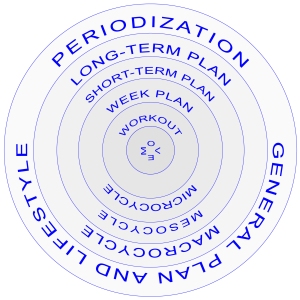Planning and Periodization Principle
(Aagaard, 2012)
By Marina Aagaard, MFE
No matter your level or goal more likely than not you will have more fun and get better results, if you make some sort of plan. You may plan in more or less detail according to your needs.
Based on theory and practice from international gymnastics and strength training, for your information and inspiration; 10 steps to periodization, that will raise motivation, training experience and results to a higher level.
You can find numerous books on periodization – and each of the 10 steps – however, from the below tips, you will get an excellent overview and be able to outline you own long- and short-term plan today. It does not have to be all that difficult and it may well be the start of a whole new approach to fitness and physical exercise.
- Needs analysis
- Capacity analysis
- Testing
- Goal setting
- Overall general plan
- Long-term plan
- Short-term plan
- Week plan
- Workout plan
- Training
1. Needs analysis (work demand analysis)
Establish your mail goal, what is needed; what do you want from your exercise program? E.g. hypertrophy, fatburning, increased strength, better balance.
If your goal is improved sports performance, it is the requirements of your sport, the muscular and energy fitness needs of the sport, that dictates the plan; look to 1) the rules and 2) the sports’ results at present (scores, time, distance, aesthetic qualities, etc.).
2. Capacity analysis (screening, health and physical form)
You must define your present ability and performance level in comparison to your needs or the demands of the sport. Initially, before testing and training find out: How is your health, are you healthy and well, without illness and injuries, and how is your physique?
A poor health does not have to keep you away from fitness and sports, but you may need a special program designed by a therapist or training specialist.
3. Testing (general/specific)
Determine your strengths and weaknesses. Perform an assessment, a physical test; cardiovascular, strength, coordination including balance and mobility.
You can also do a sports specific test; reaction time, agility, tactics and technique.
Testing is essential for assessing your starting point, so you can make a better, specific plan – and testing (results) may increase motivation during workouts.
4. Goal setting (primary goal and secondary, long- and short-term goals)
Goal setting is crucial. Establish your main goal and time frame. Then establish long-term and short-term goals, e.g. the primary goals for each period. These goals serve also as markers of progress – is the plan working?
5. Overall general plan (or long-term plan)
Outline the overall long-term general plan (goals) for sport, exercise and lifestyle.
For elite athletes this could involve a career plan and a 8-12-year plan towards the Olympic Games.
6. Long-term plan (macroycle)
The long-term plan is a ½-1 year plan from the starting date to the target date or competition. The long-term plan can be illustrated as a sort of timeline or schedule diagram. This gives you an overview of each period, when and what, volume and intensity.
The long-term plan is an excellent guide, it tells you, when your goals should be reached and helps you create better short-term plans.
7. Short-term plan (mesocycle)
The short-term plans, mesocycles, are written into the long-term plan, so you get an overview of the structure, period goals, duration and volume.
This overview is essential, as it is the basis for creating the week plans, microcycles. Depending on the goal, e.g. improved fitness or sports performance, the periods may differ, e.g. from 1-3 months, with a varying number of microcycles.
It may turn out, that results deviate from the expected outcome, so the goals and content of each period need to be adjusted along the way.
8. Week plan (microcycle)
The week plan is a plan for all of your training during a week: A FIT-schedule with Frequency, number of workouts, Intensity, load on energy systems and muscles, and Time, workout duration.
Make a schedule diagram; it makes it easier to see how different modalities of exercise can be sequenced in order to obtain the best results; optimal load (volume) and optimal recovery with minimal risk of overtraining (or undertraining).
9. Program (workout plan, WOD, Workout of the Day)
Every workout should be based on a plan or program; e.g. two programs if you have separate cardio and strength workouts.
You can work out one or more times during the day.
The workout is based on exercises or moves aimed at reaching the goal of the day (week/period).
You may repeat the program during the week or you may have different programs depending on your goals and options.
Your program should include a warm-up, specific exercises for one or more physcial capacities and cooldown with stretching as needed.
10. Training
The training itself must be with good technique in order to provide the desired results. Also, in order to know if the program is working as it is intended to, you must stick to your workout plan.
However, it does happen, that your energy level fluctuates and ‘deviations’ occur; e.g. overtime at work, taxing study assignments, illness or holidays.
This means, that you will have to adjust your plan accordingly.
After a period of training, you may re-test yourself – or the person you are training – and revise your excisting plan or set up a new plan with new goals.
Happy planning and training!
“In the deserts of Sudan and the gardens of Japan
From Milan to Yucatan, ev’ry woman, ev’ry man” …
periodize your programs, make a better plan;
improve all your capacities and every skill at hand.

